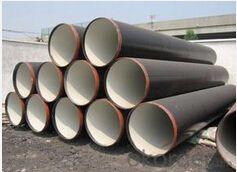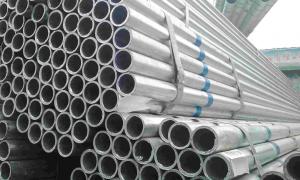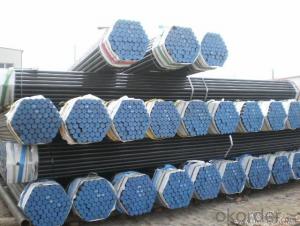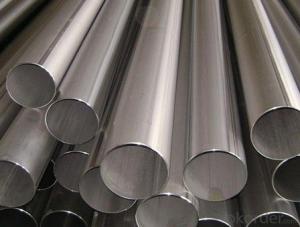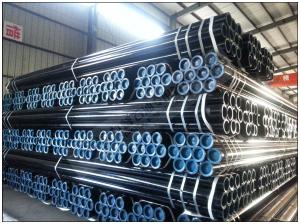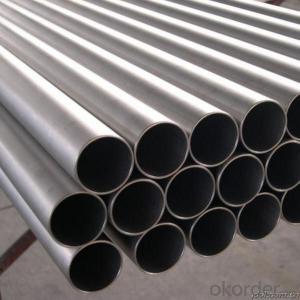API 5L seamless steel pipe line pipe for liquid transportation
- Loading Port:
- Tianjin
- Payment Terms:
- TT OR LC
- Min Order Qty:
- 25 m.t.
- Supply Capability:
- 60000 m.t./month
OKorder Service Pledge
OKorder Financial Service
You Might Also Like
Packaging & Delivery
| Packaging Detail: | in bundles by steel strips , and if required ,wrapped with PE cloth |
| Delivery Detail: | according to the quantity |
Specifications
API 5L seamless steel pipe/ASTM A106/A53
1)A,B, X42, X46, X52, X56, X60, X65, X70
2)OD:13.7-6-762MM
3)WT: 1-80MM
API 5L seamless steel pipe/ASTM A106/A53
1)A,B, X42, X46, X52, X56, X60, X65, X70, St37,ST52,
2)OD:13.7-6-762MM
3)WT: 1-80MM
SCH20,40,80
1. ends can be Threaded and Coupling
2. Aplication :tramsmission of petroleum, nature gas,water,air ect
3. Pipe Coating:
FBE (Fusion bong epoxy) coating
3PE (Three layer polyethylene) coating
3PP (Three layer polypropylene) coating
4. Cement mortar lining
Internal lining for drinkable water
Internal flow coating
5.Standard acc to: SY/T0135, SY/T0413, DIN30670/1/8, AWWAC205/210, etc
Steel grade | Machenic property | Chemical composition | ||||||||||||
σs | σb | δ5 | C | Si | Mn | P | S | Nb | V | Ti | Cr | Ni | Cu | |
min | min | min | max | max | max | max | max | min | min | min | max | max | max | |
A | 207 | 311 | 0.21 | - | 0.90 | 0.04 | 0.05 | - | - | - | - | - | - | |
B | 241 | 413 | 0.26 | - | 1.15 | 0.04 | 0.05 | - | - | - | - | - | - | |
X42 | 289 | 413 | 0.28 | - | 1.25 | 0.04 | 0.05 | - | - | - | - | - | - | |
X46 | 317 | 434 | 0.30 | - | 1.35 | 0.04 | 0.05 | - | - | - | - | - | - | |
X52 | 358 | 455 | 0.30 | - | 1.35 | 0.04 | 0.05 | - | - | - | - | - | - | |
X56 | 386 | 489 | 0.26 | - | 1.35 | 0.04 | 0.05 | 0.005 | 0.02 | 0.03 | - | - | - | |
X60 | 413 | 517 | 0.26 | - | 1.35 | 0.04 | 0.05 | 0.005 | 0.02 | 0.03 | - | - | - | |
X65 | 448 | 530 | 0.26 | - | 1.40 | 0.04 | 0.05 | 0.005 | 0.02 | - | - | - | - | |
X70 | 482 | 565 | 0.23 | - | 1.60 | 0.04 | 0.05 | - | - | - | - | - | - | |
- Q: What are the common applications of steel pipes in the water distribution system?
- Steel pipes are commonly used in water distribution systems for various applications such as transporting water from treatment plants to homes, buildings, and industries, as well as for underground water mains and fire hydrant systems.
- Q: Seamless steel pipe is how to do it?
- Seamless steel tube is a kind of steel strip with hollow section and without seams. A steel pipe having a hollow cross section, used as a conduit for conveying fluids, such as pipelines for transporting petroleum, natural gas, gas, water, and certain solid materials. Compared withsteel and roundsteelinsolid, flexural torsional strength in the same time, the weight is light, is a kind of economic section steel, widely used in the manufacture of structural parts and mechanical parts, such as the oil pipe, automobile transmission shaft, the bicycle frame and steel construction with scaffold. The manufacture of ring parts with steel tubes can improve material utilization, simplify manufacturing processes, save materials and work hours, such as rolling bearings, rings, Jack sleeves, etc., and have been widely used in steel pipes. Steel pipe or all kinds of conventional weapons indispensable materials, gun barrels are made of steel. The steel pipe can be divided into round tube and special-shaped pipe according to the sectional area shape. Because the circle area is the largest under the condition of equal circumference, more fluid can be transported with round tubes. In addition, the ring section in the internal or external radial pressure is more uniform force, so most of the steel pipe is round tube.
- Q: Can steel pipes be used for conveying compressed air?
- Yes, steel pipes can be used for conveying compressed air. Steel pipes are known for their high strength and durability, making them suitable for handling high-pressure applications such as compressed air systems. Additionally, steel pipes are resistant to corrosion and can withstand extreme temperatures, making them a reliable choice for conveying compressed air.
- Q: What are the different grades of steel used for pipes?
- Pipes are manufactured using various grades of steel, each possessing unique properties and applications. Some commonly utilized grades include: 1. Carbon Steel: This type of steel is widely employed in pipe manufacturing, particularly for low-pressure purposes. It contains a low carbon content, typically less than 0.30%, facilitating easy welding and forming. Carbon steel pipes are known for their durability and cost-effectiveness, making them suitable for diverse industries. 2. Stainless Steel: Stainless steel pipes are renowned for their corrosion resistance and high strength. They consist of an alloy of iron and chromium, with additional elements like nickel and molybdenum enhancing their properties. These pipes find extensive usage in industries such as chemical processing, food production, and oil and gas, where corrosion resistance is vital. 3. Alloy Steel: Alloy steel pipes are created by incorporating elements like manganese, chromium, or nickel into carbon steel. This enhances their strength, hardness, and wear resistance, rendering them appropriate for high-pressure and high-temperature applications. Industries such as power generation, petrochemical, and aerospace frequently employ alloy steel pipes. 4. Duplex Steel: Duplex steel represents a type of stainless steel that combines austenite and ferrite phases. This results in a material possessing exceptional strength, corrosion resistance, and toughness. Duplex steel pipes are commonly utilized in offshore oil and gas platforms, as well as in chemical and petrochemical industries. 5. Low-Temperature Steel: Low-temperature steel is specifically designed to withstand extremely cold temperatures without becoming brittle. These pipes find significant use in industries such as cryogenic storage, LNG transportation, and refrigeration. Choosing the appropriate grade of steel is crucial to ensure optimal pipe performance and longevity. Factors such as temperature, pressure, corrosion resistance, and cost should be taken into account when selecting the steel grade for pipes.
- Q: Can steel pipes be painted or coated?
- Yes, steel pipes can be painted or coated. Painting or coating steel pipes is a common practice to protect them from corrosion, improve their appearance, or to meet specific industry requirements. The process involves cleaning the pipes to remove dirt, grease, and rust, followed by applying a primer and then the desired paint or coating. The choice of paint or coating depends on the intended use of the pipes. For example, epoxy coatings are often used for water or wastewater pipelines, while high-temperature resistant coatings are applied to pipes used in industrial settings. Overall, painting or coating steel pipes can enhance their durability and performance.
- Q: How are steel pipes used in agriculture?
- Steel pipes are widely used in agriculture for various purposes. One common application is irrigation systems. Steel pipes can be used to transport water from a water source, such as a well or a reservoir, to different areas of a farm. These pipes are durable and can withstand the pressure of water, making them ideal for long-distance water transportation. Additionally, steel pipes are also used for drainage systems in agriculture. They can be used to remove excess water from fields, preventing waterlogging and ensuring proper drainage. Steel pipes are resistant to corrosion, which is important in agricultural settings where they may be exposed to moisture and various chemicals. Moreover, steel pipes are used in the construction of greenhouse structures. They provide structural support for the greenhouse framework and allow for the installation of irrigation systems and other equipment. Steel pipes are strong, sturdy, and can withstand harsh weather conditions, making them suitable for greenhouse construction. Furthermore, steel pipes are utilized in livestock farming. They are commonly used to create fences and enclosures for animals, providing a secure and durable barrier. Steel pipes are also used in the construction of animal shelters and barns. In summary, steel pipes play a crucial role in agriculture. They are used for irrigation systems, drainage systems, greenhouse construction, and livestock farming. Their durability, strength, and resistance to corrosion make them an excellent choice for various agricultural applications.
- Q: Can galvanized pipe be welded with seamless steel tube? What should I do to connect?
- To look at the use of concrete after welding, if the stress is relatively large and thin galvanized pipe wall is recommended to not use welding, if the requirement is not high Po mouth welding should be welding depends on galvanized pipe material selection electrode generally no sealing material are 20
- Q: What are the different types of steel pipe elbows?
- There are various industries and applications that commonly utilize different types of steel pipe elbows. These types encompass: 1. 90-degree elbows: Employed when redirecting fluid or gas flow requires a sharp 90-degree bend. They find extensive use in plumbing, construction, and industrial piping systems. 2. 45-degree elbows: Similar to 90-degree elbows, these elbows alter flow direction, but with a smaller angle. They are suitable for situations requiring a more gradual change in flow direction. 3. Long radius elbows: Differing from standard elbows, long radius elbows possess a larger curvature radius. This design minimizes fluid friction and pressure drop, making them ideal for applications necessitating smoother flow, such as high-flow systems or those involving viscous fluids. 4. Short radius elbows: In contrast, short radius elbows feature a smaller curvature radius. They are generally utilized in confined spaces where a compact design is essential, although they may lead to increased fluid friction and higher pressure drops. 5. Reducing elbows: These elbows are ideal for connecting pipes of varying diameters. With one end having a larger diameter and the other end with a smaller diameter, they enable a seamless transition between two pipes of different sizes. 6. Mitered elbows: Mitered elbows are tailor-made elbows fabricated by cutting and welding multiple pipe sections at specific angles. They are frequently employed when standard elbows cannot accommodate the required angle or when a unique design is necessary. In conclusion, the selection of the appropriate type of steel pipe elbow depends on factors such as the specific application, fluid flow requirements, space limitations, and compatibility with the piping system.
- Q: What is the lifespan of steel pipes?
- The lifespan of steel pipes can vary depending on various factors such as the quality of the steel used, the environment in which they are installed, and the maintenance and care they receive. However, typically, steel pipes can last for several decades or even up to a century if properly installed and maintained.
- Q: What are the different methods of protecting steel pipes from corrosion?
- There are several methods of protecting steel pipes from corrosion. One common method is coating the pipes with materials such as epoxy, polyethylene, or fusion bonded epoxy, which create a barrier between the pipe's surface and corrosive elements. Another method is cathodic protection, which involves using sacrificial anodes or impressed current to prevent corrosion. Additionally, applying corrosion inhibitors or using corrosion-resistant alloys for manufacturing the pipes can provide protection. Regular maintenance, including inspections and cleaning, is also crucial to ensure the ongoing protection of steel pipes from corrosion.
Send your message to us
API 5L seamless steel pipe line pipe for liquid transportation
- Loading Port:
- Tianjin
- Payment Terms:
- TT OR LC
- Min Order Qty:
- 25 m.t.
- Supply Capability:
- 60000 m.t./month
OKorder Service Pledge
OKorder Financial Service
Similar products
Hot products
Hot Searches
Related keywords

